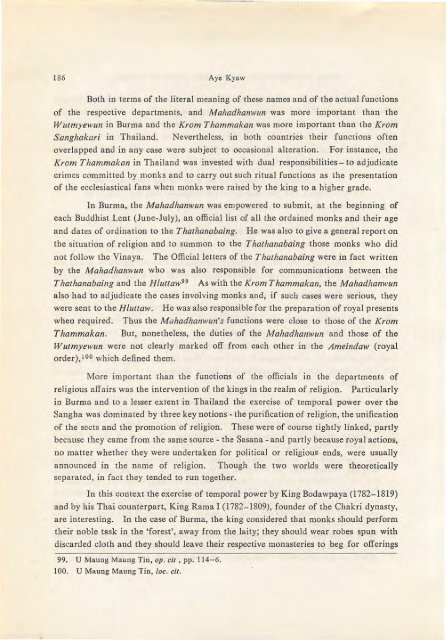The Journal of the Siam Society Vol. LXXII, Part 1-2, 1984 - Khamkoo
The Journal of the Siam Society Vol. LXXII, Part 1-2, 1984 - Khamkoo
The Journal of the Siam Society Vol. LXXII, Part 1-2, 1984 - Khamkoo
You also want an ePaper? Increase the reach of your titles
YUMPU automatically turns print PDFs into web optimized ePapers that Google loves.
186 Aye Kyaw<br />
Both in terms <strong>of</strong> <strong>the</strong> literal meaning <strong>of</strong> <strong>the</strong>se names and <strong>of</strong> <strong>the</strong> actual functions<br />
<strong>of</strong> <strong>the</strong> respective departments, and Mahadhanwun was more important than <strong>the</strong><br />
Wutmyewun in Burma and <strong>the</strong> Krom Thammakan was more important than <strong>the</strong> Krom<br />
Sanghakari in Thailand. Never<strong>the</strong>less, in both cou.ntries <strong>the</strong>ir functions <strong>of</strong>ten<br />
overlapped and in any case were subject to occasional alteration. For instance, <strong>the</strong><br />
Krorn T hammakan in Thailand was invested with dual responsibilities - to adjudicate<br />
crimes committed by monks and to carry out such ritual functions as <strong>the</strong> presentation<br />
<strong>of</strong> <strong>the</strong> ecclesiastical fans when monks were raised by <strong>the</strong> king to a higher grade.<br />
In Burma, <strong>the</strong> Mahadhanwun was empowered to submit, at <strong>the</strong> beginning <strong>of</strong><br />
each Buddhist Lent (June-July), an <strong>of</strong>ficial list <strong>of</strong> all <strong>the</strong> ordained monks and <strong>the</strong>ir age<br />
and dates <strong>of</strong> ordination to <strong>the</strong> Thathanabaing. He was also to give a general report on<br />
<strong>the</strong> situation <strong>of</strong> religion and to summon to <strong>the</strong> Thathanabaing those monks who did<br />
not follow <strong>the</strong> Vinaya.<br />
<strong>The</strong> Official letters <strong>of</strong> <strong>the</strong> Thathanabaing were in fact written<br />
by <strong>the</strong> Mahadhanwun who was also responsible for communications between <strong>the</strong><br />
Thathanabaing and <strong>the</strong> Hluttaw9 9 As with <strong>the</strong> Krom Thammakan, <strong>the</strong> Mahadhanwun<br />
also had to adjudicate <strong>the</strong> cases involving monks and, if such cases were serious, <strong>the</strong>y<br />
were sent to <strong>the</strong> Hluttaw. He was also responsible for <strong>the</strong> preparation <strong>of</strong> royal presents<br />
when required. Thus <strong>the</strong> Mahadhanwun's functions were close to those <strong>of</strong> <strong>the</strong> Krom<br />
Thammakan. But, none<strong>the</strong>less, <strong>the</strong> duties <strong>of</strong> <strong>the</strong> Mahadhanwun and those <strong>of</strong> <strong>the</strong><br />
Wutmyewun were not clearly marked <strong>of</strong>f from each o<strong>the</strong>r in <strong>the</strong> Ameindaw (royal<br />
order),IOO which defined <strong>the</strong>m.<br />
More important than <strong>the</strong> functions <strong>of</strong> <strong>the</strong> <strong>of</strong>ficials in <strong>the</strong> departments <strong>of</strong><br />
religious affairs was <strong>the</strong> intervention <strong>of</strong> <strong>the</strong> kings in <strong>the</strong> realm <strong>of</strong> religion.<br />
<strong>Part</strong>icularly<br />
in Burma and to a lesser extent in Thailand <strong>the</strong> exercise <strong>of</strong> temporal power over <strong>the</strong><br />
Sangha was dominated by three key notions- <strong>the</strong> purification <strong>of</strong> religion, <strong>the</strong> unification<br />
<strong>of</strong> <strong>the</strong> sects and <strong>the</strong> promotion <strong>of</strong> religion. <strong>The</strong>se were <strong>of</strong> course tightly linked, partly<br />
because <strong>the</strong>y came from <strong>the</strong> same source- <strong>the</strong> Sasana - and partly because royal actions,<br />
no matter whe<strong>the</strong>r <strong>the</strong>y were undertaken for political or religious ends, were usually<br />
announced in <strong>the</strong> name <strong>of</strong> religion. Though <strong>the</strong> two worlds were <strong>the</strong>oretically<br />
separated, in fact <strong>the</strong>y tended to run toge<strong>the</strong>r.<br />
In this context <strong>the</strong> exercise <strong>of</strong> temporal power by King Bodawpaya (1782-1819)<br />
and by his Thai counterpart, King Rama I (1782-1809), founder <strong>of</strong> <strong>the</strong> Chakri dynasty,<br />
are interesting. In <strong>the</strong> case <strong>of</strong> Burma, <strong>the</strong> king considered that monks should perform<br />
<strong>the</strong>ir noble task in <strong>the</strong> 'forest', away from <strong>the</strong> laity; <strong>the</strong>y should wear robes spun with<br />
discarded cloth and <strong>the</strong>y should leave <strong>the</strong>ir respective monasteries to beg for <strong>of</strong>ferings<br />
99. U Maung Maung Tin, op. cit , pp. 114-6.<br />
100. U Maung Maung Tin, lac. cit.

















